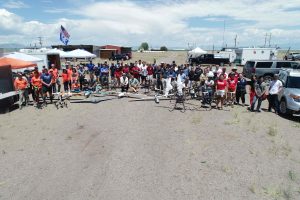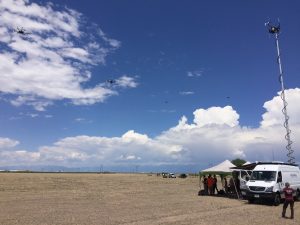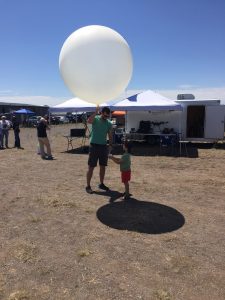This is Gijs de Boer, signing on to provide a guest post to Kevin’s blog – really excited to be able to provide perhaps a slightly different perspective on things from what he will share!
Yesterday we welcomed members of the San Luis Valley community, media and student groups to Leach Airport in Center, Colorado to check out what operating UAS for atmospheric science is all about. Over the course of the morning, people of all ages were able to ask questions, check out equipment, watch some calibration flights, and generally interact with the students and researchers deployed for the 2018 ISARRA flight week. The activity included a panel discussion, during which some great questions came up about how these systems can help us to predict rain, understand energy transfer, improve seasonal forecasts and understand wind patterns. There was even a question about whether it would hail yesterday or not (it didn’t!). All in all, the event was a great success.

Flight week participants from all institutions pose with some of their equipment during community day (photo: Oklahoma State)

The University of Colorado IRISS team discusses their equipment with local students.
The rest of the day was spent calibrating instrumentation by flying a defined flight pattern in proximity to a tower that extends from the CU mobile operations vehicle. The weather held up and we were able to get most systems calibrated. Not a small feat when you have nearly 40 systems to calibrate in a day!

Cross-calibration activities alongside the University of Colorado MURC vehicle.
Today, we conducted our first science flight day. Teams were spread across the San Luis Valley to collect profiles of atmospheric parameters between 8:00 am and 2:30 pm in order to assess the evolution of the lower atmosphere and try to help answer why convective clouds form where and when they do. In addition, the ground-based instruments will be running continuously during the campaign and weather balloons will be launched frequently (eight of them tomorrow, over two sites!). A lot of data to be analyzed down the road!

Sean Waugh of the National Severe Storms Laboratory gets some help from a young community day participant.
